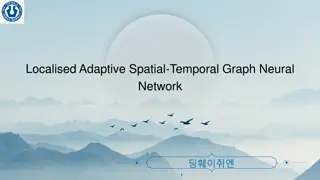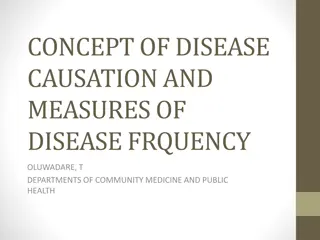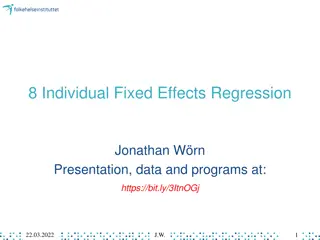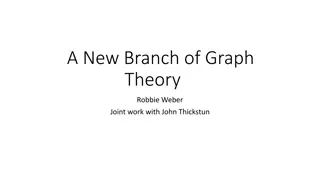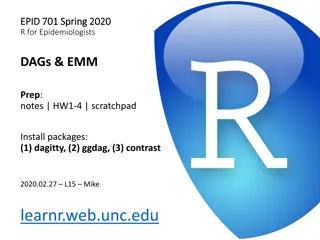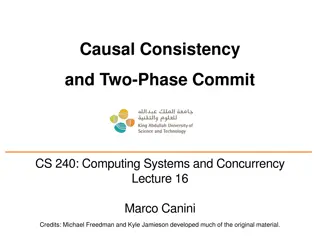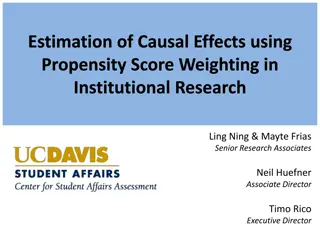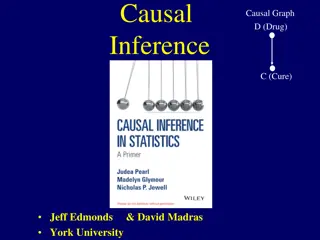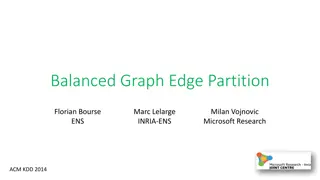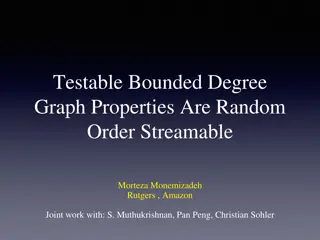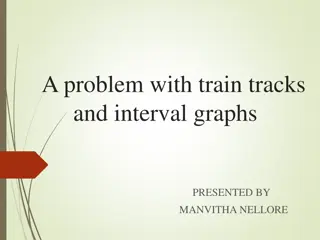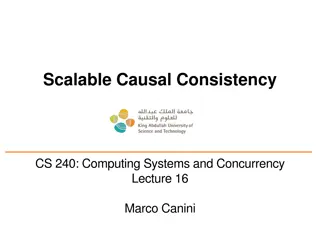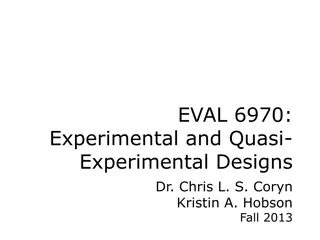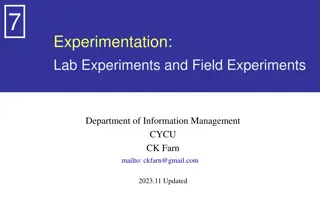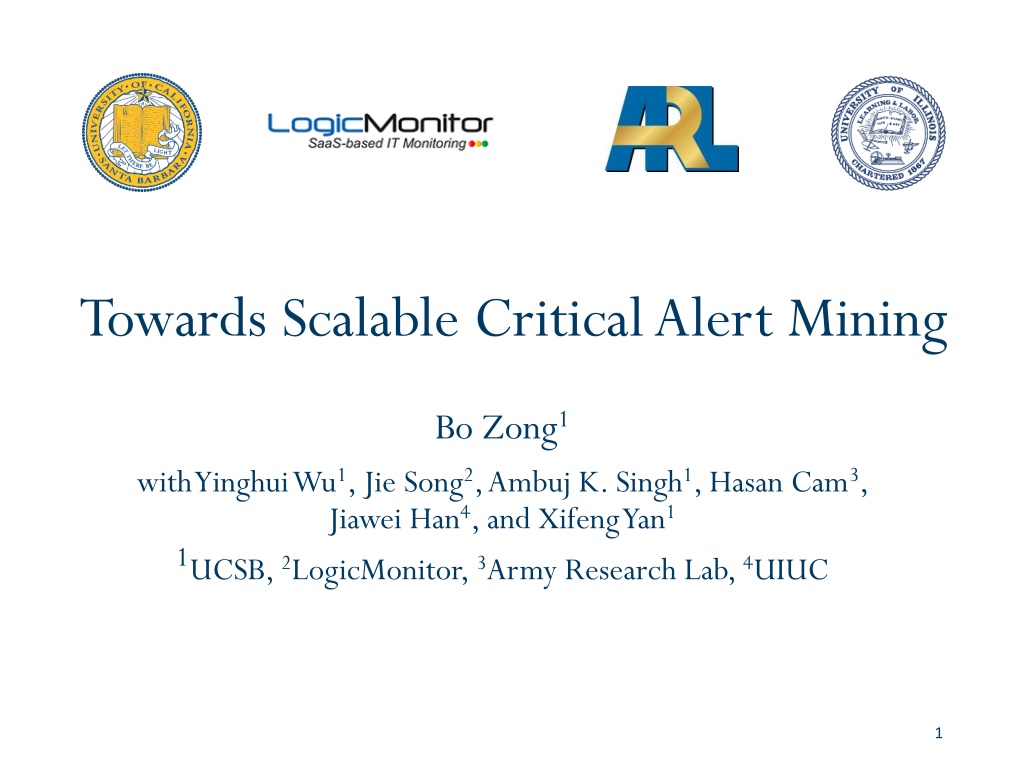
Scalable Critical Alert Mining in Complex Systems
Explore the forefront of scalable critical alert mining in complex systems through big data analytics, system malfunction detection, and efficient mining of critical alerts. Discover the insights and strategies for automated system management and on-demand alert mining.
Download Presentation

Please find below an Image/Link to download the presentation.
The content on the website is provided AS IS for your information and personal use only. It may not be sold, licensed, or shared on other websites without obtaining consent from the author. If you encounter any issues during the download, it is possible that the publisher has removed the file from their server.
You are allowed to download the files provided on this website for personal or commercial use, subject to the condition that they are used lawfully. All files are the property of their respective owners.
The content on the website is provided AS IS for your information and personal use only. It may not be sold, licensed, or shared on other websites without obtaining consent from the author.
E N D
Presentation Transcript
Towards Scalable Critical Alert Mining Bo Zong1 with Yinghui Wu1, Jie Song2, Ambuj K. Singh1, Hasan Cam3, Jiawei Han4, and Xifeng Yan1 1UCSB, 2LogicMonitor, 3Army Research Lab, 4UIUC 1
Big Data Analytics in Automated System Management Complex systems are ubiquitous Nuclear power plant Social media Computer network Chemical production system Software system Aircraft system Tons of monitoring data generated from complex systems Big data analytics are desired to extract knowledge from massive data and automate complex system management 2
Massive Monitoring Data in Complex Systems Example: monitoring data in computer networks @Server-A Monitoring data Data center #MongoDB backup jobs: Apache response lag: Mysql-Innodb buffer pool: 120-server data center can generate monitoring data 40GB/day SDA write-time: 3
System Malfunction Detection via Alerts Example: alerts in computer networks Alert @server-A 01:20am: #MongoDB backup jobs 30 01:30am: Memory usage 90% 01:31am: Apache response lag 2 seconds 01:43am: SDA write-time 10 times slower than average performance 09:32pm: #MySQL full join 10 09:47pm: CPU usage 85% 09:48pm: HTTP-80 no response 10:04pm: Storage used 90% Which alert should I start with? Monitoring data Complex systems could have many issues For the 40GB/day data generated from the 120-server data center, we will collect 20k+ alerts/day 4
Mining Critical Alerts Example: critical alerts in computer networks Critical! Disk Read Latency @Server-A CPU cores busy @Server-B #MongoDB backup jobs @Server-B CPU cores busy @Server-B MongoDB busy @Server-B Mcollective reg status @Server-C How to efficiently mine critical alerts from massive monitoring data? 5
Pipeline Our focus Offline dependency rule mining On-demand critical alert mining Online alert graph maintenance [0, 1, , 1, 1] [1, 1, , 1, 0] [0, 0, , 1, 1] History alert log user Dependency rules t3time t2 t1 Incoming alerts Alert graph Offline dependency rule mining Online alert graph maintenance On-demand critical alert mining 6
Alert Graph Alert graphs are directed acyclic (DAG) Nodes: alerts derived from monitoring data Edges Indicate the probabilistic dependency between two alerts Direction: from one older alert to another younger alert Weight: the probability that the dependency holds Example A ? C|A = 0.9 means A has probability 0.9 to be the cause of C Alert graph G How to measure an alert is critical? 0.72 0.1 0.9 0.71 C 0.5 0.5 0.3 0.6 0.8 0.7 7
Gain of Addressing Alerts If alert u is addressed, alerts caused by u will disappear Given a subset of alerts S are addressed, ?(?|S) is the probability that alert u will disappear The cause of u disappears given S is addressed ? ?|S = 1 (1 ?(?|S) ?(?|?)) ? ??????(?) Given a subset of alerts S are addressed, Gain(S) quantifies the benefit of addressing S Gain S = ? S,? ? V ?(S,?) quantifies the impact from S to alert u If ? ?,? = ?(?|S), Gain(S) is the expected number of alerts will disappear given alerts in S are addressed 8
Critical Alert Mining Input Which are the top-5 critical alerts? An alert graph G = (V,E) k, #wanted alerts Output: S V such that S = k Gain(S) is maximized Related problems Critical Alert Mining is not #P hard as Influence Maximization, since alert graphs are DAGs Bayesian network inference enables fast conditional probability computation, but cannot efficiently solve top-k queries 9
Naive Greedy Algorithm Greedy search strategy Alert graph G Find the alert u such that S ? has the largest incremental gain B A S 0.72 { } A B 0.1 0.9 0.71 0.5 0.5 0.3 0.6 0.8 0.7 Greedy algorithms have approximation ratio 1 -1 ? ( 0.63) Efficiency issue: time complexity O(k|V||E|) How to speed up greedy algorithms? 10
Bound and Pruning Algorithm (BnP) Pruning unpromising alerts by upper and lower bounds Alert graph G A Bound estimation Upper Lower 0.72 0.1 2.5 Gain(S {A}) 4 0.9 0.71 C 1.2 Gain(S {C}) 2 Unpromising LocalGain 0.5 0.5 0.3 0.6 0.8 0.7 SumGain Drawback: pruning might not always work Can we trade a little approximation quality for better efficiency? 11
Single-Tree Approximation If an alert graph is a tree, a (1 1 algorithm runs in O(k|V|) ?)-approximation Intuition: sparsify alert graphs into trees, preserving most information Maximum directed spanning trees are trees in an alert graph Span all nodes in an alert graph Sum of edge weights is maximized 12
Single-Tree Approximation (cont.) Linear-time algorithm to search maximum directed spanning tree T* G Tree Gain 0.72 0.72 sparsification estimation 0.1 0.1 Gain 0.9 0.9 0.71 0.5 0.5 0.5 0.3 0.3 0.6 0.8 0.8 0.7 0.7 Drawback: accuracy loss in Gain estimation Edge of the highest weight is always selected Edges of similar weight never get selected 13
Multi-Tree Approximation Sample multiple trees from an alert graph T1 Gain estimation G GainT1 Tree sampling 0.72 0.1 0.9 0.71 . Average Gain 0.5 0.5 Gain 0.3 0.6 TL 0.8 0.7 GainTL 14
Experimental Results Efficiency comparison on LogicMonitor alert graphs BnP is 30 times faster than the baseline Multi-tree approximation is 80 times faster with 0.1 quality loss Single-tree approximation is 5000 times faster with 0.2 quality loss 15
Conclusion Critical alert mining is an important topic for automated system management in complex systems A pipeline is proposed to enable critical alert mining Tree approximation practically works well for critical alert mining Future work Critical alert mining with domain knowledge Alert pattern mining if two groups of alerts follow the same dependency pattern, they might result from the same problem Alert pattern querying if we have a solution to a problem, we apply the same solution when we meet the problem again 16
Questions? Thank you! 17
Experiment Setup Real-life data from LogicMonitor 50k performance metrics from 122 servers Spans 53 days Offline dependency rule mining Training data: the latest 7 consecutive days Mined 46 set of rules (starting from the 8th day) Learning algorithm: Granger causality Alert graphs Constructed 46 alert graphs #nodes: 20k ~ 25k #edges: 162k ~ 270k 18
Case study 19



